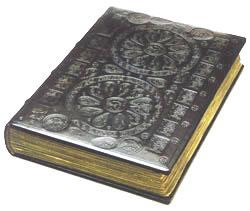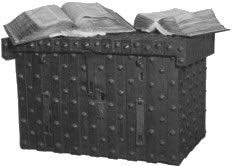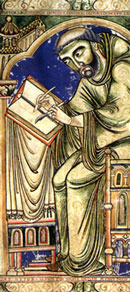

Metal detecting holidays in England with the World's most successful metal detecting club.
Twinned with Midwest Historical Research Society USA
|
Domesday
Book
|
|
Three of the sites we have permission to hunt are listed in the Domesday book with all the villages, pigs, slaves, houses etc attached on the site entry. One particular site has 10 pigs in the wood, 1 plough, 2 villages, 2 slaves and 2 houses noted !! This is what they paid tax on.
The Domesday Book was commissioned in December 1085 by William the Conqueror, who invaded England in 1066. The first draft was completed in August 1086 and contained records for 13,418 settlements in the English counties south of the rivers Ribble and Tees (the border with Scotland at the time). The original Domesday Book has survived over 900 years of English history and is currently housed in a specially made chest at London's Public Record Office in Kew, London What is the Domesday Book? The Domesday Book is a great land survey from 1086, commissioned by William the Conqueror to assess the extent of the land and resources being owned in England at the time, and the extent of the taxes he could raise. The information collected was recorded by hand in two huge books, in the space of around a year. William died before it was fully completed.
Why is it called the 'Domesday' Book? It was written by an observer of the survey that "there was no single hide nor a yard of land, nor indeed one ox nor one cow nor one pig which was left out". The grand and comprehensive scale on which the Domesday survey took place and the irreversible nature of the information collected led people to compare it to the Last Judgement, or 'Doomsday', described in the Bible, when the deeds of Christians written in the Book of Life were to be placed before God for judgement. This name was not adopted until the late 12th Century. What information is in the book?
However, the Domesday Book does not provide an accurate indication of the population of England towards the end of the 11th century How was the information collected? Royal commissioners
were sent out around England to collect and record the information from
thousands of settlements; the country was split up into 7 regions, or
'circuits' of the country, with 3 or 4 commissioners being assigned
to each. They carried with them a set of questions and put these to
a jury of representatives - made up of barons and villagers alike -
from each county. They wrote down all of the information in Latin, as
with the final Domesday document itself. Once they returned to London
the information was combined with earlier records, from both before
and after the Conquest, and was then, circuit by circuit, entered into
the final Domesday Book.
When was the Book written? The collection of information by the commissioners took place probably in the first few months of 1086, followed by the amalgamation of this and existing information into lengthy drafts. These were possibly finished by the end of the summer of 1086, with work on abbreviating the records into the Great Domesday (see below) probably starting alongside this. By the time of King William's death in September 1087 work had stopped, and could have ceased before this time. Although the Great Domesday Book was left incomplete, the draft of the remaining unabbreviated work (the East Anglian circuit) remains as the Little Domesday Book (see below). Who wrote the Domesday Book? Incredibly the final version of the main Domesday Book volume, all 413 pages of it, was handwritten by one unnamed official scribe, and checked by one other. Despite the speed at which the Book was compiled the text was carefully written in a short form of Latin. Why was it made?
What materials were used to make it? The main volume, Great Domesday, is written on sheep-skin parchment using black and red ink only (red used for the county titles atop each page, and corrections and alterations).
How many places are listed in the Domesday Book? There are 13,418 places listed in the Domesday Book. How many books make up the whole of the Domesday survey? The survey was intended to be compiled into one complete volume, but the compilation was never fully completed, probably owing to King William's death before the sole scribe could finish his work. However, the information collected from the whole survey was retained and still exists today in 2 volumes: 'Great Domesday' - most of the counties, abridged, and 'Little Domesday' - the 3 counties missing from Great Domesday, in their unabridged form. See more about the two books here. How many pages are there in the Domesday Book? There are 413 pages in Great Domesday (see above) and 475 pages in Little Domesday (which shows how much detail was cut out to compile Great Domesday). How many places listed in the Domesday Book still exist? Amazingly almost all of the places mentioned in the Domesday Book can be found on a present day map of England (and Wales), though many of their names have been altered over time from their 11th century versions. Why were many places listed in the Domesday Book as 'wasted'? When William and his army invaded in 1066 they continued their conquest campaign towards western and northern England, leaving a fair amount of destruction in their wake. The term 'waste' or 'wasted' appears many times in the Domesday Book, most often describing settlements the army had passed through and left their mark on during their conquest, although the term was also used sometimes for manors simply not paying geld for one reason or another.
|


 The
Domesday Book provides extensive records of landholders, their tenants,
the amount of land they owned, how many people occupied the land (villagers,
smallholders, free men, slaves, etc.), the amounts of woodland, meadow,
animals, fish and ploughs on the land (if there were any) and other
resources, any buildings present (churches, castles, mills, salthouses,
etc.), and the whole purpose of the survey - the value of the land and
its assets, before the Norman Conquest, after it, and at the time of
Domesday. Some entries also chronicle disputes over who held land, some
mention customary dues that had to be paid to the king, and entries
for major towns include records of traders and number of houses.
The
Domesday Book provides extensive records of landholders, their tenants,
the amount of land they owned, how many people occupied the land (villagers,
smallholders, free men, slaves, etc.), the amounts of woodland, meadow,
animals, fish and ploughs on the land (if there were any) and other
resources, any buildings present (churches, castles, mills, salthouses,
etc.), and the whole purpose of the survey - the value of the land and
its assets, before the Norman Conquest, after it, and at the time of
Domesday. Some entries also chronicle disputes over who held land, some
mention customary dues that had to be paid to the king, and entries
for major towns include records of traders and number of houses.  With
the need to defend England from possible invasion threats from Scandinavia,
and costly campaigns being fought in northern France, the vast army
William amassed required substantial funding. The power to raise Danegeld
- a uniform tax to pay for the defence of the country - had been inherited
from the Anglo-Saxons, and William saw the need for the Domesday Book
as a thorough assessment of the potential amount of tax he could raise
from his subjects and their assets. The survey also served as a gauge
of the country's economic and social state in the aftermath of the Conquest
and the unrest that followed it.
With
the need to defend England from possible invasion threats from Scandinavia,
and costly campaigns being fought in northern France, the vast army
William amassed required substantial funding. The power to raise Danegeld
- a uniform tax to pay for the defence of the country - had been inherited
from the Anglo-Saxons, and William saw the need for the Domesday Book
as a thorough assessment of the potential amount of tax he could raise
from his subjects and their assets. The survey also served as a gauge
of the country's economic and social state in the aftermath of the Conquest
and the unrest that followed it. 
